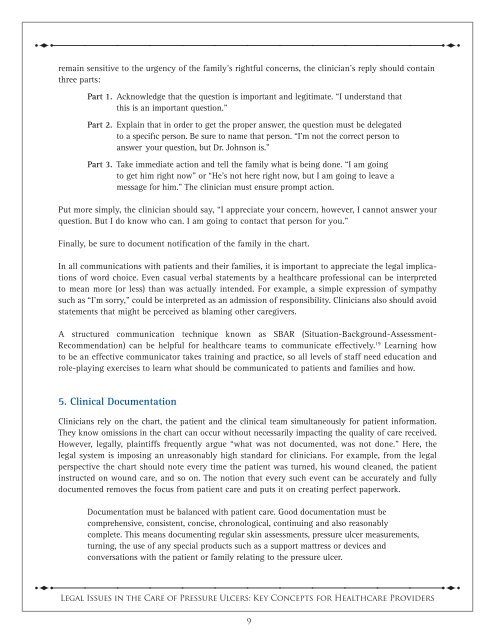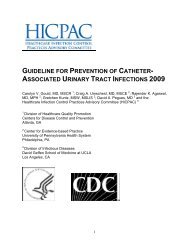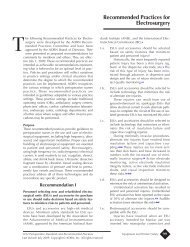Legal Issues in the Care of Pressure Ulcer Patients - Medline
Legal Issues in the Care of Pressure Ulcer Patients - Medline
Legal Issues in the Care of Pressure Ulcer Patients - Medline
Create successful ePaper yourself
Turn your PDF publications into a flip-book with our unique Google optimized e-Paper software.
sttttttttttttsrema<strong>in</strong> sensitive to <strong>the</strong> urgency <strong>of</strong> <strong>the</strong> family’s rightful concerns, <strong>the</strong> cl<strong>in</strong>ician’s reply should conta<strong>in</strong>three parts:Part 1. Acknowledge that <strong>the</strong> question is important and legitimate. “I understand thatthis is an important question.”Part 2. Expla<strong>in</strong> that <strong>in</strong> order to get <strong>the</strong> proper answer, <strong>the</strong> question must be delegatedto a specific person. Be sure to name that person. “I’m not <strong>the</strong> correct person toanswer your question, but Dr. Johnson is.”Part 3. Take immediate action and tell <strong>the</strong> family what is be<strong>in</strong>g done. “I am go<strong>in</strong>gto get him right now” or “He’s not here right now, but I am go<strong>in</strong>g to leave amessage for him.” The cl<strong>in</strong>ician must ensure prompt action.Put more simply, <strong>the</strong> cl<strong>in</strong>ician should say, “I appreciate your concern, however, I cannot answer yourquestion. But I do know who can. I am go<strong>in</strong>g to contact that person for you.”F<strong>in</strong>ally, be sure to document notification <strong>of</strong> <strong>the</strong> family <strong>in</strong> <strong>the</strong> chart.In all communications with patients and <strong>the</strong>ir families, it is important to appreciate <strong>the</strong> legal implications<strong>of</strong> word choice. Even casual verbal statements by a healthcare pr<strong>of</strong>essional can be <strong>in</strong>terpretedto mean more (or less) than was actually <strong>in</strong>tended. For example, a simple expression <strong>of</strong> sympathysuch as “I’m sorry,” could be <strong>in</strong>terpreted as an admission <strong>of</strong> responsibility. Cl<strong>in</strong>icians also should avoidstatements that might be perceived as blam<strong>in</strong>g o<strong>the</strong>r caregivers.A structured communication technique known as SBAR (Situation-Background-Assessment-Recommendation) can be helpful for healthcare teams to communicate effectively. 19 Learn<strong>in</strong>g howto be an effective communicator takes tra<strong>in</strong><strong>in</strong>g and practice, so all levels <strong>of</strong> staff need education androle-play<strong>in</strong>g exercises to learn what should be communicated to patients and families and how.5. Cl<strong>in</strong>ical DocumentationCl<strong>in</strong>icians rely on <strong>the</strong> chart, <strong>the</strong> patient and <strong>the</strong> cl<strong>in</strong>ical team simultaneously for patient <strong>in</strong>formation.They know omissions <strong>in</strong> <strong>the</strong> chart can occur without necessarily impact<strong>in</strong>g <strong>the</strong> quality <strong>of</strong> care received.However, legally, pla<strong>in</strong>tiffs frequently argue “what was not documented, was not done.” Here, <strong>the</strong>legal system is impos<strong>in</strong>g an unreasonably high standard for cl<strong>in</strong>icians. For example, from <strong>the</strong> legalperspective <strong>the</strong> chart should note every time <strong>the</strong> patient was turned, his wound cleaned, <strong>the</strong> patient<strong>in</strong>structed on wound care, and so on. The notion that every such event can be accurately and fullydocumented removes <strong>the</strong> focus from patient care and puts it on creat<strong>in</strong>g perfect paperwork.Documentation must be balanced with patient care. Good documentation must becomprehensive, consistent, concise, chronological, cont<strong>in</strong>u<strong>in</strong>g and also reasonablycomplete. This means document<strong>in</strong>g regular sk<strong>in</strong> assessments, pressure ulcer measurements,turn<strong>in</strong>g, <strong>the</strong> use <strong>of</strong> any special products such as a support mattress or devices andconversations with <strong>the</strong> patient or family relat<strong>in</strong>g to <strong>the</strong> pressure ulcer.stttttttttttts<strong>Legal</strong> <strong>Issues</strong> <strong>in</strong> <strong>the</strong> <strong>Care</strong> <strong>of</strong> <strong>Pressure</strong> <strong>Ulcer</strong>s: Key Concepts for Healthcare Providers9
















